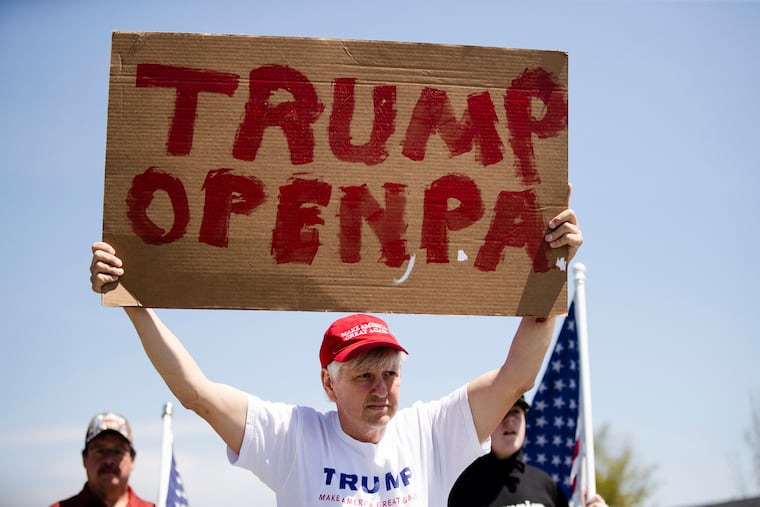4 reasons Trump could still win Pa., despite Biden’s lead in the polls | Opinion
Recent polls show Joe Biden leading President Donald Trump, but there’s a lot underneath the surface of those numbers.

On primary election day 2016, I got an eye-opening lesson about the Trump phenomenon in Pennsylvania. As a local Republican committeeman, I regularly provide transportation to the polls for those who need it. That day, an elderly woman asked me for a ride to her polling place.
I was happy to accommodate her because I had an ulterior motive: I was on the ballot for delegate to the Republican National Convention, and I needed her vote. Early that morning, I dutifully drove her to cast her ballot, then thanked her for making the effort to get to the polls and voting for me. “Oh, I couldn’t vote for you this time,” she replied. As she delivered the bad news, she clutched a small piece of paper. It contained the Trump-endorsed slate of delegate candidates. My name wasn’t one of them.
That evening, I got more lessons. Donald Trump won every Pennsylvania county, something that had never been done in a contested primary. From the big cities through suburban neighborhoods to rural areas where the deer outnumber humans, Trump won them all. His delegate candidates followed in his wake, winning improbable victories everywhere.
» READ MORE: Republicans are trying to survive an anti-Trump wave in the Philly suburbs: ‘A lot of Democrats vote for me’
Trump beat the conservative wing of the GOP represented by Ted Cruz, and the moderate wing led by John Kasich. He beat them everywhere, and he beat them soundly. When the general election campaign got underway, Pennsylvania Democrats and the media talked up their vaunted “Blue Wall.” Anchored by the Keystone State, the wall ran across the Rust Belt, carrying with it enough electoral votes to guarantee Hillary Clinton’s election.
On Election Day, that Blue Wall collapsed like a bad soufflé. Trump won virtually every state along it — flipping Pennsylvania, Ohio, Michigan, and Wisconsin, and taking the electoral votes that put him in the White House. Four years later, Democrats, buoyed by electoral successes in the 2018 midterms, are talking about their wall again. But the bricks look as loosely cemented today as they were in 2016.
Few disagree that Pennsylvania’s 20 electoral votes will be crucial to the 2020 outcome, and Republicans haven’t fared too well through the years in the Keystone State. Trump’s 2016 victory there was the first by a GOP presidential standard-bearer in almost 30 years.
Pennsylvania Democrats have outnumbered Republicans by more than one million registrants for most of these years — but that’s starting to change.
» READ MORE: Pennsylvania’s impact on 2020 election comes down to Luzerne vs. Chester Counties | Opinion
Since Trump’s 2016 Pennsylvania win, Republicans have narrowed the registration gap statewide by almost 150,000. Much of those gains have come in areas that had been reliably blue. National media often overlook the shift of working-class Democrats to the Trump coalition, a development that’s key to understanding what’s going on in Pennsylvania.
While the Philly suburbs have trended bluer for decades, the other corner of the state has emerged in recent years as red and getting redder. Trump has accelerated the trend in southwestern Pennsylvania. Joe Biden and Kamala Harris’ declared war on coal and natural gas, which would cost the commonwealth hundreds of thousands of high-paying jobs, is driving union households into the Trump column.
The same shift is taking place in northeast Pennsylvania, especially in Luzerne County, once considered safely Democrat, but now swinging for Trump. Just a stone’s throw from Biden’s birthplace, the county went for Barack Obama in 2008 and 2012 — but Trump carried it in 2016, and since then the trends have continued moving his way. The county’s Democratic state senator switched his registration to independent and now caucuses with the GOP. Republicans took the majority on the county council and dramatically increased their registration.
Trump’s stunning Pennsylvania victory in 2016 came by a razor-thin margin, and it figures to be a squeaker again this year. But voter passion and energy are on Trump’s side. Driving down the backroads of Pennsylvania, one sees reminders of Trump’s drawing power. Spray-painted on plywood and splashed onto cardboard with tempera paint is a simple message:
T-R-U-M-P. Thousands of Trump campaign signs are planted on suburban lawns.
A mid-August poll by Muhlenberg College showed Biden holding a four-point lead in Pennsylvania; a more recent CNBC poll had Biden’s lead at three. That’s essentially a margin-of-error race. But there’s a lot underneath the surface of those numbers.
First, Trump always outperforms the polls. He will do so in Pennsylvania again.
» READ MORE: Biden is beating Trump big in Pennsylvania. Will anything change that?
Second, the enthusiasm gap is wide and growing. Trump’s voters will turn out, just as they did in this year’s primary, when Pennsylvania Republicans showed up in force, even though there were no statewide contests on their ballots. They wanted to vote for Trump. This year, it’s Trump voters, not Democrats, who are marking days off their calendars leading up to Election Day.
Third, the Philadelphia suburbs may not go as far left as Biden believes. Violent crime and urban riots are worrying suburbanites, especially women, who have wavered on Trump. Likewise, Biden’s proposed huge tax increases would hit suburban pocketbooks hard.
Finally, presidential elections usually show a significant swing after Labor Day — and the trend right now is running in Trump’s direction. It will be an all-out battle in the Keystone State. Memo to the Biden campaign: I know a lady in central Pennsylvania you can cross off your list.
Charlie Gerow is a Republican strategist and CEO of Quantum Communications in Harrisburg. A version of this piece originally appeared on RealClear Politics.